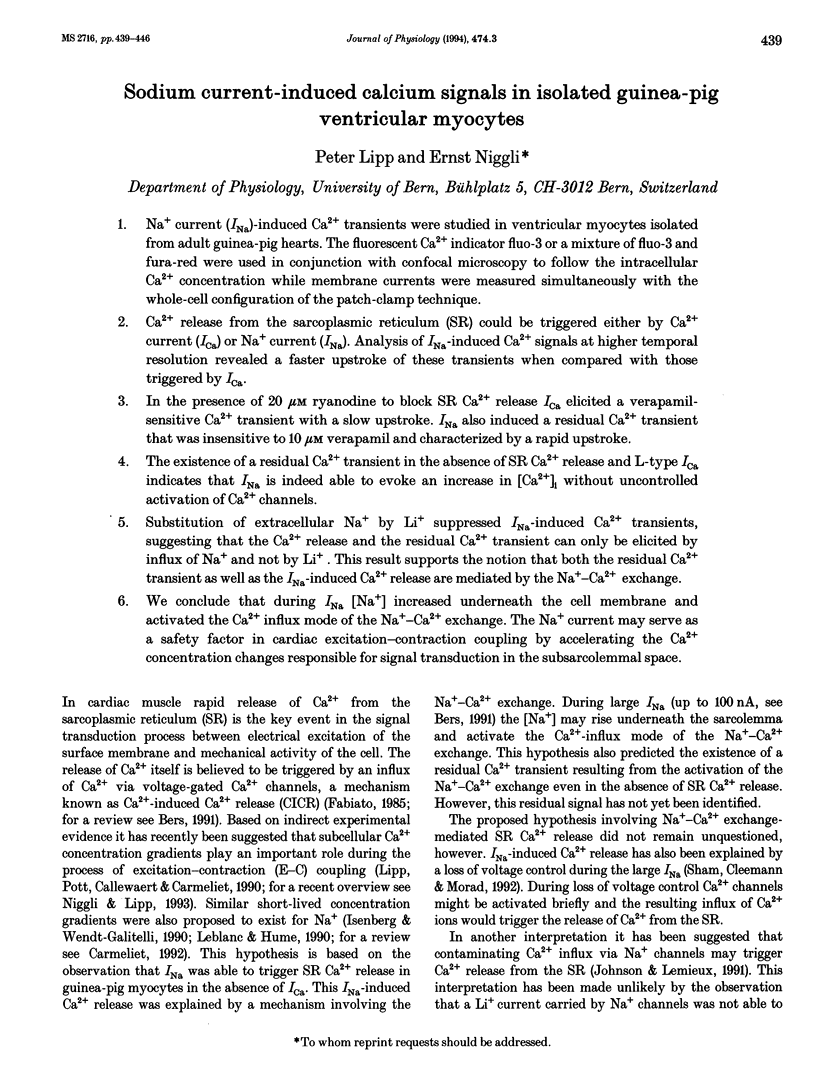Sodium current-induced calcium signals in isolated guinea-pig ventricular myocytes (original) (raw)
Abstract
1. Na+ current (INa)-induced Ca2+ transients were studied in ventricular myocytes isolated from adult guinea-pig hearts. The fluorescent Ca2+ indicator fluo-3 or a mixture of fluo-3 and fura-red were used in conjunction with confocal microscopy to follow the intracellular Ca2+ concentration while membrane currents were measured simultaneously with the whole-cell configuration of the patch-clamp technique. 2. Ca2+ release from the sarcoplasmic reticulum (SR) could be triggered either by Ca2+ current (ICa) or Na+ current (INa). Analysis of INa-induced Ca2+ signals at higher temporal resolution revealed a faster upstroke of these transients when compared with those triggered by ICa. 3. In the presence of 20 microM ryanodine to block SR Ca2+ release ICa elicited a verapamil-sensitive Ca2+ transient with a slow upstroke. INa also induced a residual Ca2+ transient that was insensitive to 10 microM verapamil and characterized by a rapid upstroke. 4. The existence of a residual Ca2+ transient in the absence of SR Ca2+ release and L-type ICa indicates that INa is indeed able to evoke an increase in [Ca2+]i without uncontrolled activation of Ca2+ channels. 5. Substitution of extracellular Na+ by Li+ suppressed INa-induced Ca2+ transients, suggesting that the Ca2+ release and the residual Ca2+ transient can only be elicited by influx of Na+ and not by Li+. This result supports the notion that both the residual Ca2+ transient as well as the INa-induced Ca2+ release are mediated by the Na(+)-Ca2+ exchange.(ABSTRACT TRUNCATED AT 250 WORDS)

Images in this article
Selected References
These references are in PubMed. This may not be the complete list of references from this article.
- Cannell M. B., Berlin J. R., Lederer W. J. Effect of membrane potential changes on the calcium transient in single rat cardiac muscle cells. Science. 1987 Dec 4;238(4832):1419–1423. doi: 10.1126/science.2446391. [DOI] [PubMed] [Google Scholar]
- Carmeliet E. A fuzzy subsarcolemmal space for intracellular Na+ in cardiac cells? Cardiovasc Res. 1992 May;26(5):433–442. doi: 10.1093/cvr/26.5.433. [DOI] [PubMed] [Google Scholar]
- Eberhard M., Erne P. Kinetics of calcium binding to fluo-3 determined by stopped-flow fluorescence. Biochem Biophys Res Commun. 1989 Aug 30;163(1):309–314. doi: 10.1016/0006-291x(89)92136-0. [DOI] [PubMed] [Google Scholar]
- Fabiato A. Rapid ionic modifications during the aequorin-detected calcium transient in a skinned canine cardiac Purkinje cell. J Gen Physiol. 1985 Feb;85(2):189–246. doi: 10.1085/jgp.85.2.189. [DOI] [PMC free article] [PubMed] [Google Scholar]
- Leblanc N., Hume J. R. Sodium current-induced release of calcium from cardiac sarcoplasmic reticulum. Science. 1990 Apr 20;248(4953):372–376. doi: 10.1126/science.2158146. [DOI] [PubMed] [Google Scholar]
- Lederer W. J., Niggli E., Hadley R. W. Response. Science. 1991 Mar 15;251(4999):1371–1371. doi: 10.1126/science.251.4999.1371. [DOI] [PubMed] [Google Scholar]
- Lederer W. J., Niggli E., Hadley R. W. Sodium-calcium exchange in excitable cells: fuzzy space. Science. 1990 Apr 20;248(4953):283–283. doi: 10.1126/science.2326638. [DOI] [PubMed] [Google Scholar]
- Lipp P., Niggli E. Ratiometric confocal Ca(2+)-measurements with visible wavelength indicators in isolated cardiac myocytes. Cell Calcium. 1993 May;14(5):359–372. doi: 10.1016/0143-4160(93)90040-d. [DOI] [PubMed] [Google Scholar]
- Lipp P., Pott L., Callewaert G., Carmeliet E. Calcium transients caused by calcium entry are influenced by the sarcoplasmic reticulum in guinea-pig atrial myocytes. J Physiol. 1992 Aug;454:321–338. doi: 10.1113/jphysiol.1992.sp019266. [DOI] [PMC free article] [PubMed] [Google Scholar]
- Lipp P., Pott L., Callewaert G., Carmeliet E. Simultaneous recording of Indo-1 fluorescence and Na+/Ca2+ exchange current reveals two components of Ca2(+)-release from sarcoplasmic reticulum of cardiac atrial myocytes. FEBS Lett. 1990 Nov 26;275(1-2):181–184. doi: 10.1016/0014-5793(90)81467-3. [DOI] [PubMed] [Google Scholar]
- Niggli E., Lipp P. Subcellular restricted spaces: significance for cell signalling and excitation-contraction coupling. J Muscle Res Cell Motil. 1993 Jun;14(3):288–291. doi: 10.1007/BF00123093. [DOI] [PubMed] [Google Scholar]
- Näbauer M., Callewaert G., Cleemann L., Morad M. Regulation of calcium release is gated by calcium current, not gating charge, in cardiac myocytes. Science. 1989 May 19;244(4906):800–803. doi: 10.1126/science.2543067. [DOI] [PubMed] [Google Scholar]
- Sham J. S., Cleemann L., Morad M. Gating of the cardiac Ca2+ release channel: the role of Na+ current and Na(+)-Ca2+ exchange. Science. 1992 Feb 14;255(5046):850–853. doi: 10.1126/science.1311127. [DOI] [PubMed] [Google Scholar]
- Sodium-calcium exchange. Science. 1991 Mar 15;251(4999):1370–1371. [PubMed] [Google Scholar]